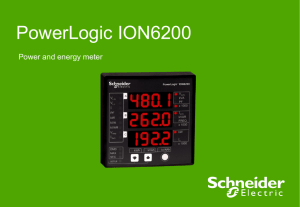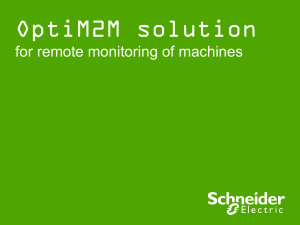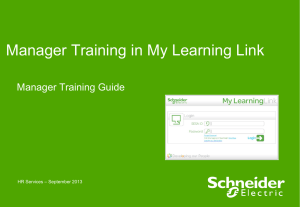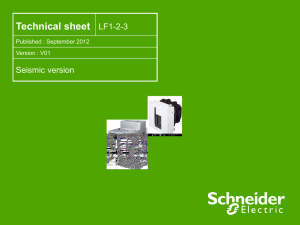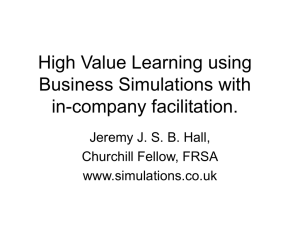Chapter 1
advertisement
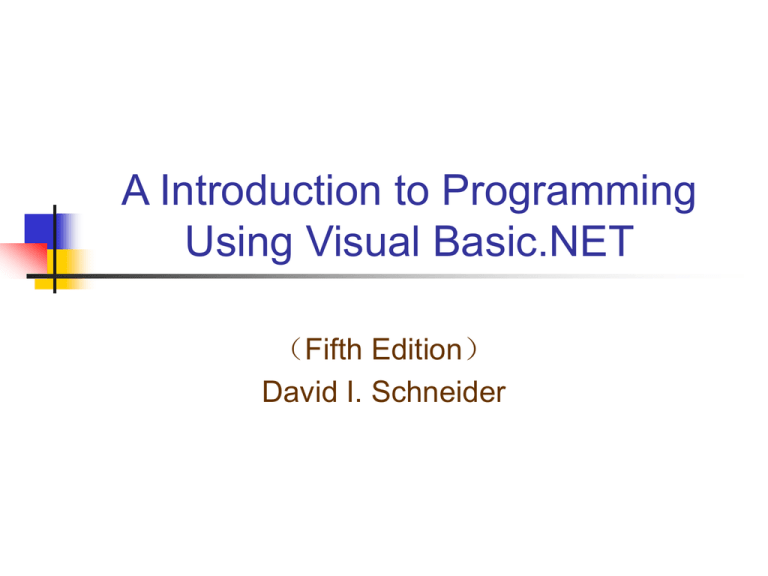
A Introduction to Programming Using Visual Basic.NET (Fifth Edition) David I. Schneider Instructor Name:Liang Jiankun E-Mail:teacherljk@163.com Phone: 23986531 Office: Computer Center Chapter 1 An Introduction to Computers and Visual Basic.NET Chapter 1 - VB.NET by Schneider 3 Outline and Objectives • • • • • Sect.1: Introduction to Computers Sect.2: Using Windows Sect.3: Files and Folders Sect.4: An Introduction to Visual Basic.NET Sect.5: Biographical History of Computing Chapter 1 - VB.NET by Schneider 4 Sect.1 Introduction to Computers • Personal computer vs. Server • What are the main components of a PC • What are some uses of computers in our society • What are some topics covered in this text that students could use immediately • How do we communicate with the computer • How do we get computers to perform complicated tasks Chapter 1 - VB.NET by Schneider 5 Sect.1 Introduction to Computers (cont.) • Are there certain features that all programs have in common • Hardware vs. Software • Programmer vs. User • How did VB.NET evolve • What is the Internet and how did it come about • What is the World Wide Web and how is that different from the Internet Chapter 1 - VB.NET by Schneider 6 Sect.1 Introduction to Computers Some important and essential topics: Topic1: Personal Computer vs. Server • PC means a computer that is operated by one person at a time • Server means a computer that provides resources (files, printers, internet access etc.) to other computers Chapter 1 - VB.NET by Schneider 7 Sect.1 Introduction to Computers Some important and essential topics: Topic2: The main components of a PC Chapter 1 - VB.NET by Schneider 8 Sect.1 Introduction to Computers Some important and essential topics: Topic2: The main components of a PC (cont.) • Devices hidden from view inside the System Unit – Microprocessor named CPU(Central Processing Unit) the CPU can be thought of as the brain of the computer, carries out all computations Chapter 1 - VB.NET by Schneider 9 Sect.1 Introduction to Computers Some important and essential topics: Topic2: The main components of a PC (cont.) • Devices hidden from view inside the System Unit – Microprocessor named CPU(Central Processing Unit) – Memory named RAM(Random Access Memory) the memory stores the instructions and data being processed by the computer. the contents will be lost when the computer’s power is turned off! . Chapter 1 - VB.NET by Schneider 10 Sect.1 Introduction to Computers Some important and essential topics: Topic2: The main components of a PC (cont.) • Devices hidden from view inside the System Unit – Microprocessor named CPU(Central Processing Unit) – Memory named RAM(Random Access Memory) – Hard disk drive, Floppy drive, CD driver the hard disk and CD-ROM is used to store instructions and data for long time purpose. The data will not be lost when the power is off. Chapter 1 - VB.NET by Schneider 11 Sect.1 Introduction to Computers 1—slot for APG graphics card(AGP显卡插槽) 2—slot for PCI devices 3—BIOS chip 4—chip of mainboard • Devices hidden from view inside the System Unit (north bridge北桥芯片) – Microprocessor named CPU(Central Processing Unit) 5—interface for floppy driver– Memory named RAM(Random Access Memory) 6,7—interface for IDE – Hard disk drive, Floppy drive, CD driver devices – Mainboard 8—interface for ATX – Mainboard (or motherboard) is the primary power(ATX电源接口) 9—slot for RAMcomponent of a computer. It is the hub 10—slot for CPUwhich is used to connect all of the computer's important components . 11—interface for peripheral equipment (外部设备接口) Some important and essential topics: Topic2: The main components of a PC (cont.) Chapter 1 - VB.NET by Schneider 12 Sect.1 Introduction to Computers Some important and essential topics: Topic2: The main components of a PC (cont.) • Devices hidden from view inside the System Unit – – – – – – – Microprocessor named CPU(Central Processing Unit) Memory named RAM(Random Access Memory) Hard disk drive, Floppy drive, CD driver Mainboard Graphics card Network card Sound card Chapter 1 - VB.NET by Schneider 13 Sect.1 Introduction to Computers Some important and essential topics: Topic3: Hardware vs. Software • Hardware – the physical components of a computer ALU (Arithmetic Logical Unit) 运算器 CPU 中央处理器 控制器 Control Unit hardware Memorizer 存储器 internal memory 内存储器 external memory 外存储器 Input Device 输入设备 输入/输出设备(I/O设备) Output Device 输出设备 • Software – The instructions that tell the computer what to do – Operating System, Microsoft Office, Photoshop, etc. Chapter 1 - VB.NET by Schneider 14 Sect.1 Introduction to Computers Some important and essential topics: Topic4: How do we communicate with the computer • Low level language: hard understand for human Machine language (机器语言,composed of 0 and 1) assembly language (汇编语言) • High level language: easy understand for human C C++ C# VB Java Chapter 1 - VB.NET by Schneider 15 Sect.1 Introduction to Computers Some important and essential topics: Topic5: Programmer vs. User • Programmer – the person who writes the instructions (or programs) for the computer to solve problems. – Pay much attention to the code (how to write it). • User – any person who uses the program – Pay attention to the interface of the program (how to use it) Chapter 1 - VB.NET by Schneider 16 Sect.2 Using Windows • • • • Topic1: Mouse Pointers Topic2: Mouse action Topic3: Windows and windows Topic4: Using the Notepad Chapter 1 - VB.NET by Schneider 17 Topic1: Mouse Pointers Two basic types of mouse pointers: • arrow • hourglass Chapter 1 - VB.NET by Schneider 18 Topic2: Mouse Actions • • • • • Pointing Hovering Clicking Double-Clicking Dragging Chapter 1 - VB.NET by Schneider 19 Topic3: Windows and windows Windows • a kind of Operating System which organizes the screen into rectangular regions. Each region likes a window • window • a rectangular region in which an application runs inside – Title Bar – Active window Chapter 1 - VB.NET by Schneider 20 Topic4: Using the Notepad • Notepad is an elementary word processor included with Windows and is installed by default under the Accessories program group • Most of the methods used for notepad can be applied to other Windows applications. • The methods to invoke an application Click the ico of the application from Start Menu Type the application’s name in run box from Start Menu Double click a file associated with the application Chapter 1 - VB.NET by Schneider 21 Notepad • 4. The largest part of the window where the 2.document is edited. • Cursor is the blinking vertical line where you can delete and insert letters. 1. 3. Chapter 1 - VB.NET by Schneider 22 Notepad 2. 4. 1. • show the document’s name • three control buttons on the right side named minimize, maximize (restore), close button • system menu button • move the position of he window • adjust the 3. size of the window Chapter 1 - VB.NET by Schneider 23 Notepad 2. 4. 1. • Vertical and Horizontal scroll bar • The arrows is used for small increments • The scroll box is used for moving quickly 3. Chapter 1 - VB.NET by Schneider 24 Notepad 2. 4. 1. 3. Chapter 1 - VB.NET by Schneider 25 Notepad 4. Important keys for most text editors: • Home, Ctrl+Home 2. • End, Ctrl+End • Back Space, Del • Ctrl+Back Space, Ctrl+Del • Alt/O/W (open Word Wrap feature) • Access keys • Shortcut keys 1. 5. Important keys for text editors 3. Chapter 1 - VB.NET by Schneider 26 Sect.3 Files & Folders: • • • • Disk is a permanent storage. A disk can store thousands of files. A disk drive is identified by a letter. To organize your files you have to store them in different folders (directories). Chapter 1 - VB.NET by Schneider 27 Key Terms in using Folders • Root folder • Path Example: Filename C:\VB01\VB.EXE Drive letter • File Specification: You should always know • composed of the base name, the period and the extension. where you are saving your files (driver letter + • can be up to 215 characters (except \, /,:,*,?,”,<,>,|). colon + path + file name). Chapter 1 - VB.NET by Schneider 28 Explorer window Chapter 1 - VB.NET by Schneider 29 Using Windows Explorer • • • • • • Hide a file or folder Show hide attribute files and folders Show or hide file extensions for known file types Add or remove read-only attribute Copy or remove files and folders Rename and delete operation Chapter 1 - VB.NET by Schneider 30 Sect.4 the evolution of Visual Basic • • • • • • • Version 1.0 – 1991 Version 2.0 – 1992 Version 3.0 – 1993 Version 4.0 – 1995 Version 5.0 – 1997 Version 6.0 – 1998 VB.NET – 2002(not backward compatible with early versions) • VB 2005 • VB 2008 • VB 2010 Chapter 1 - VB.NET by Schneider 31 Sect.5 Biographical History of Computing • There are lots of people we should never forget. They made important contributions to the evolution of computing. Chapter 1 - VB.NET by Schneider 32 Charles Babbage(查理斯·巴贝奇) • 1792-1871,British mathematician and engineer • The inventor of “analytical engine” • Devised the five main department of modern computers (Input, Output, Memory, Arithmetic Logical Unit, Control Unit) • The father of the computer Chapter 1 - VB.NET by Schneider 33 Alan Turing(阿兰·图灵) • 1912-1954, A gifted and far-sighted British mathematician • deciphered German code and changed the course of WWII • the inventor of “Turing Machine” • father of artificial intelligence • Suicide death Chapter 1 - VB.NET by Schneider 34 John von Neumann (冯·诺依曼) • • • • 1903-1957, Hungarian-American mathematician developed stored program concept von Neumann machines (冯诺依曼型计算机) the father of the computer Chapter 1 - VB.NET by Schneider 35 Bill Gates (比尔·盖茨) • 1955-now,cofounder of Microsoft Corporation • the richest man in the world during 2001-2007 • the inventor of PC-DOS Chapter 1 - VB.NET by Schneider 36 Many people we should remember • Search the information on website by yourself. Chapter 1 - VB.NET by Schneider 37

